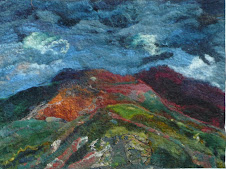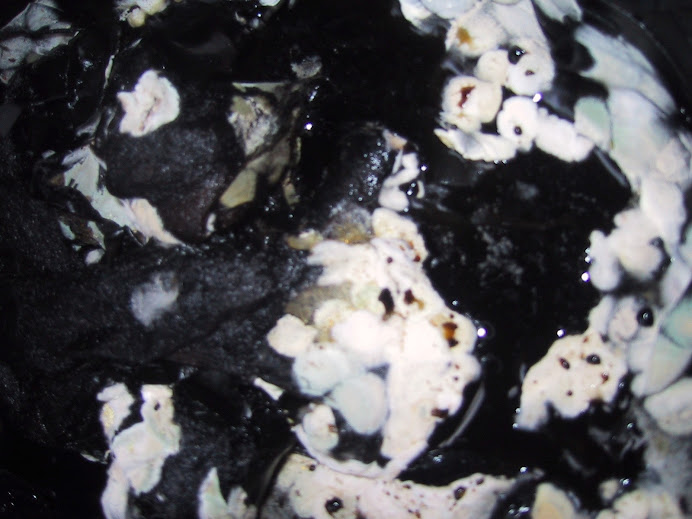




I have had a fermented indigo vat on the go now for over a month. I set it up for a Dyeing the Blues workshop in my studio at the end of August and it has been going ever since and students at my most recent Dyeing the Blues on the 24th of September were able use it. My visitors coming to visit over the past two weekends of the Helfa Gelf Open Art Studio event have been intrigued by it and a few have braved the label of "rather smelly" and asked for a demo. One male visitor who was studying, he told me, for a diploma in archaeology, lifted the lid to have a sniff presumably to get an authentic whiff of the past! I tell people that dyeing with indigotin (the proper name for the indigo blues ) is ancient, widespread and that for thousands of years this is how people have got blue and they are mostly fascinated.
This particular vat has been superb. It is a madder bran vat using woad ash lye-a 17th century recipe I originally got from Sandberg*. wood ash lye is easily made by filling a bucket with wood ash and topping up with water. After a couple of the weeks the clear water at he tops is a mixture of potassium carbonate and potassium hydroxide . During my reading for research for my indigo book (The Colour of the Sea and Sky, The Art of Indigo Dyeing) I found references to different types of woodash. It was said that woodash from oak made the best lye for fermentation vats and after that hardwoods. A local woodworker working in oak burnt all his scraps for me and made an oak ash from which I made a lye.This vat is made from that and whether for that reason or not has been superb.
The vat sits on a hotplate originally used for wine making which keeps the vat warm at between 35-to 40-degrees. Fermentation vats do like to be kept warm. The madder and the bran ferment and as they do so they use up all the oxygen in the water. At the start the wood ash lye made the vat alkaline with a pH of about 10. As fermentation proceeds it creates lactic acid and this makes the pH drop so every morning I stir the vat, check the pH adding washing soda if it has dropped . When the vat has no oxygen in and is alkaline the insoluble indigotin converts to its soluble form when it will bond to the fibres. Removing the fibres from the vat results in the oxygen in the air converting the soluble form back into the insoluble indigotin which is bonded to the fibres.
Every now and again ( such as once a week) I drop in an handful of madder and of bran and three times in the last month 10g of indigotin mixed with hot water to a paste.
The million dollar question is -why do I like the fermentation vat so much? The answer is it is so easy to use. You just put something and leave it -overnight more often then not. Oxidise and then put it back for a couple of hours for the deeper blues and you can see from the photo how dark some of my blues are. These are much more difficult to get with the modern chemical vat which has to be carefully balanced to make sure that indigotin is not stripped off as a fast as it is deposited. I also like the sense of being connected to thousands of years of history
Madder and Bran Vat
This vat has the advantage of being least smelly of the fermented vats and comes from a seventeenth century recipe. You will need:
9 litres water
60g madder
20g bran
22g indigo made to a paste
500ml of wood ash lye
Put water, madder, and bran in a pan, with the wood ash lye and heat to boiling. Boil for 15 minutes. The scum on the surface will turn pink then a rather gorgeous purple. Allow to cool to 40°C and then add the indigo paste. Maintain this temperature and stir daily.
At 40 degrees C this vat will come into order within two days but the pH will drop rapidly. Add a tablespoon of washing soda on the second day or if you see that fermentation is rapid with lots of little bubbles on the surface, and stir well. As it comes into order you will see a patina of indigo on the surface like a coppery blue sheen. The characteristic slightly murky green liquid underneath may be slightly masked by colour from the madder but experiment by dipping some fibres leave for half an hour and remove. You should then see the yellowy green colour on the fibres.
J.N. Liles The Art and Craft of Natural Dyeing: Traditional Recipes for Modern Use University of Tennessee Press ISBN 0-87049-0
Gosta Sandberg Indigo Textiles Technique and History Lark Books ISB9372274
You are most welcome to use this information on this blog for your own personal use but it is copyright Helen Melvin and the information is not to be used for commercial gain.
Ps I am still carrying on with some shibori (see previous post)



























Thank you, Helen, for posting this recipe, the description of your processing and the pictures.
ReplyDeleteI have recently been given some indigo and some madder, so maybe I'll try - but I still don't have washing soda nor do I know what it is and if I can get it somewhere near :-(
Helen, your blues are gorgeous! I love blue, esp. the dark ones and it looks so good on your shibori fabrics! I'd like to do a fermentation vat myself, but I have a problem with holding the temperature (I don't think I'd be allowed to stay in the house for much longer if I put that vat up beside the stove:)) - and I don't want to resort to using electricity to keep it up:(( well, maybe next summer....if we get one!
ReplyDeleteLove the sign on the vat!
ReplyDeleteWell, soon I'll have my own hardwood ashes, now all I need is the dye garden to go with it! Planting for that starts next spring. :)
Hi Ladka washing soda is sodium carbonate. Here,in the UK you can get it in hardware stores in the cleaning materials section. It used to be used for washing the dishes before washinh u pliquid was invented and is still used sometimes for cleaning floors etc. Hope that helps.
ReplyDeleteBettina maybe you could think of a stale urine vat outside next summer I got gorgeous blues with that.
Well Leigh hardwood ashes are a good start - wood ash lye can be used in a lot of dye recipes
This comment has been removed by the author.
ReplyDeleteFascinating, Helen! It was lovely to see your studio (and smell the vat) on Saturday with Helfa Gelf. My Dad was very impressed with the speed at which your very fine merino turns into felt - and I was very, very impressed with that wonderful crimson you got from cochineal. Any photos?
ReplyDeleteAlison
(P.S. previous post removed for typos, and because I forgot to sign it!)
Hi Alison I am glad your father enjoyed it - it was really good of him to come. No photos but you are right I will photograph it but of course I can't bnt quite remember the concentration I used. Really annoying!
ReplyDeleteThose colors would look perfect with a black Cat on them.
ReplyDeletethank you Helen for posting this.Your description makes it seem feasible- I;ll give it a try. I;ve only tried the fleece water vat from Liles, it was good with fleece and gave me light blue on yarn, but I left it alone for three days and the smell changed to rotten so I threw it out.
ReplyDeleteI have a question about lye- does it lose its potency with time? I have ashes standing in water, theyve been there a couple of months, is this still lye? I know that to put ash in the soil you have to leave it outside so it is not as caustic after a winter of rain.
thanks!
another question or two(sorry) is the madder powder or roots cut up? would wild madder do? it does ferment when left in water.
ReplyDeletealso I have found caustic soda around here, but not washing soda. I understand caustic soda is harsher than the other kind, could I use just a little bit?:-) (that is a sheepish smile)
Hi Manya I haven't found that my lye loses its potency. If anything I would expect it to get stronger overtime, The ash would get "cleaner" as the water absorbs the chemicals from the ash.
ReplyDeleteI don't see why the wild madder not work as well as ordinary madder it is the sugars in the madder which make it work or so I understand.
Washing soda is sodium carbonate, Caustic soda Sodium hydroxide. Sodium hydroxide is much stronger than sodium carbonate and even a little would kill your vat I think. If you cannot get sodium carbonate-over here you can buy it from companies selling dyes as soda ash - then I would use your wood ash lye.
I hope this all helps
I have just realised I missed a question. I use madder roots. I don't see why powder would not work but I have not tried it.
ReplyDeleteHelen, thanks for answering all my questions- I have ordered your indigo book, and now want the others too- can I change my order?
ReplyDeleteI'll email privately- thanks again!
Hi Helen,
ReplyDeleteI am looking around for indigo dye vat recipes and found this lovely site.
Do you know of another material besides madder that I can use? I am living in Israel right now and don't have any idea of where to look for it.
Thank you so much,
Aila
Hi Aila
ReplyDeleteOne of the recipes in my book -the Colour of the Sea and Sky - is one I invented myself using molasses. In other parts of the world they use yeast and sugar, dates and molasses .You need anything which will ferment and a source of slow release of sugar I use the madder bran vat because I like it.